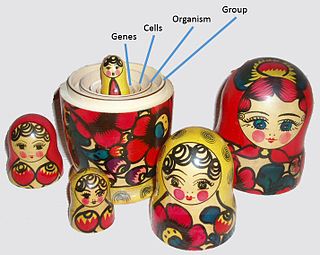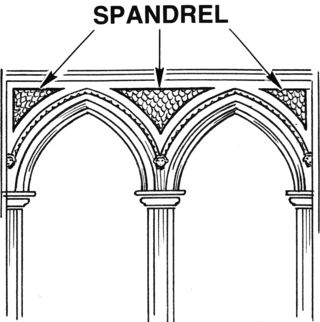Genomic imprinting is an epigenetic phenomenon that causes genes to be expressed or not, depending on whether they are inherited from the female or male parent. Genes can also be partially imprinted. Partial imprinting occurs when alleles from both parents are differently expressed rather than complete expression and complete suppression of one parent's allele. Forms of genomic imprinting have been demonstrated in fungi, plants and animals. In 2014, there were about 150 imprinted genes known in mice and about half that in humans. As of 2019, 260 imprinted genes have been reported in mice and 228 in humans.

In evolutionary biology, punctuated equilibrium is a theory that proposes that once a species appears in the fossil record, the population will become stable, showing little evolutionary change for most of its geological history. This state of little or no morphological change is called stasis. When significant evolutionary change occurs, the theory proposes that it is generally restricted to rare and geologically rapid events of branching speciation called cladogenesis. Cladogenesis is the process by which a species splits into two distinct species, rather than one species gradually transforming into another.

Theria is a subclass of mammals amongst the Theriiformes. Theria includes the eutherians and the metatherians but excludes the egg-laying monotremes and various extinct mammals evolving prior to the common ancestor of placentals and marsupials.

This is a list of topics in evolutionary biology.

Wonderful Life: The Burgess Shale and the Nature of History is a 1989 book on the evolution of Cambrian fauna by Harvard paleontologist Stephen Jay Gould. The volume made The New York Times Best Seller list, was the 1991 winner of the Royal Society's Rhone-Poulenc Prize, the American Historical Association's Forkosch Award, and was a 1991 finalist for the Pulitzer Prize. Gould described his later book Full House (1996) as a companion volume to Wonderful Life.

A unit of selection is a biological entity within the hierarchy of biological organization that is subject to natural selection. There is debate among evolutionary biologists about the extent to which evolution has been shaped by selective pressures acting at these different levels.
Exaptation and the related term co-option describe a shift in the function of a trait during evolution. For example, a trait can evolve because it served one particular function, but subsequently it may come to serve another. Exaptations are common in both anatomy and behaviour.
Adaptationism is the Darwinian view that many physical and psychological traits of organisms are evolved adaptations. Pan-adaptationism is the strong form of this, deriving from the early 20th century modern synthesis, that all traits are adaptations, a view now shared by only a few biologists.
In science and philosophy, a just-so story is an untestable narrative explanation for a cultural practice, a biological trait, or behavior of humans or other animals. The pejorative nature of the expression is an implicit criticism that reminds the listener of the fictional and unprovable nature of such an explanation. Such tales are common in folklore genres like mythology. A less pejorative term is a pourquoi story, which has been used to describe usually more mythological or otherwise traditional examples of this genre, aimed at children.
The turnover-pulse hypothesis, formulated by paleontologist Elisabeth Vrba, suggests that major changes to the climate or ecosystem often result in a period of rapid extinction and high turnover of new species across multiple different lineages. Changes may include climate change, tectonic plate shifting, and catastrophes, among other things. It can be seen as an extension of the concept of evolutionary radiation from a single to a multi-clade context.

In evolutionary biology, a spandrel is a phenotypic trait that is a byproduct of the evolution of some other characteristic, rather than a direct product of adaptive selection. Stephen Jay Gould and Richard Lewontin brought the term into biology in their 1979 paper "The Spandrels of San Marco and the Panglossian Paradigm: A Critique of the Adaptationist Programme". Adaptationism is a point of view that sees most organismal traits as adaptive products of natural selection. Gould and Lewontin sought to temper what they saw as adaptationist bias by promoting a more structuralist view of evolution.

James Alan Shapiro is an American biologist, an expert in bacterial genetics and a professor in the Department of Biochemistry and Molecular Biology at the University of Chicago.

In biology, evolution is the process of change in all forms of life over generations, and evolutionary biology is the study of how evolution occurs. Biological populations evolve through genetic changes that correspond to changes in the organisms' observable traits. Genetic changes include mutations, which are caused by damage or replication errors in organisms' DNA. As the genetic variation of a population drifts randomly over generations, natural selection gradually leads traits to become more or less common based on the relative reproductive success of organisms with those traits.

Evolutionary thought, the recognition that species change over time and the perceived understanding of how such processes work, has roots in antiquity—in the ideas of the ancient Greeks, Romans, Chinese, Church Fathers as well as in medieval Islamic science. With the beginnings of modern biological taxonomy in the late 17th century, two opposed ideas influenced Western biological thinking: essentialism, the belief that every species has essential characteristics that are unalterable, a concept which had developed from medieval Aristotelian metaphysics, and that fit well with natural theology; and the development of the new anti-Aristotelian approach to modern science: as the Enlightenment progressed, evolutionary cosmology and the mechanical philosophy spread from the physical sciences to natural history. Naturalists began to focus on the variability of species; the emergence of palaeontology with the concept of extinction further undermined static views of nature. In the early 19th century prior to Darwinism, Jean-Baptiste Lamarck (1744–1829) proposed his theory of the transmutation of species, the first fully formed theory of evolution.
The multiregional hypothesis, multiregional evolution (MRE), or polycentric hypothesis, is a scientific model that provides an alternative explanation to the more widely accepted "Out of Africa" model of monogenesis for the pattern of human evolution.
The court jester hypothesis is used in reference to the idea that abiotic forces, rather than biotic competition between species, function as a major driving force behind the processes in evolution which produce speciation. In evolutionary theory, the court-jester hypothesis contrasts the Red Queen hypothesis.

The following outline is provided as an overview of and topical guide to evolution:

Jürgen Brosius is a German molecular geneticist and evolutionary biologist. He was professor and director of the Institute of Experimental Pathology at the University of Münster. Some of his scientific contributions involve the first genetic sequencing of a ribosomal RNA operon, the design of plasmids for studying gene expression, expression vectors for high-level production of recombinant proteins and RNA, RNA biology, RNomics as well as the significance of retroposition for plasticity and evolution of genomes, genes and gene modules including regulatory sequences or elements.
The sloshing bucket model of evolution is a theory in evolutionary biology that describes how environmental disturbances varying in magnitude will affect the species present. The theory emphasizes the causal relationship between environmental factors that impinge and affect genealogical systems, providing an overarching view that determines the relationship between the variety of biological systems.
Architectural exaptation is a concept in architecture and urban design that involves repurposing buildings, structures, or architectural elements for new uses that differ significantly from their original intended purpose. This practice extends beyond mere adaptation, as it involves a transformative process where the original functions are replaced or augmented by entirely new ones. It is a concept that embraces flexibility, creativity, and innovation in the use of architectural spaces and structures.











